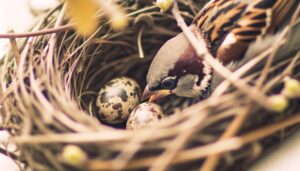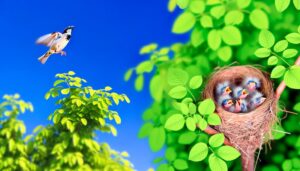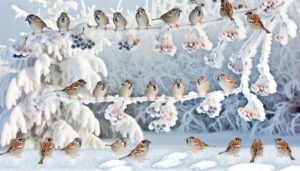How Do Sparrows Learn to Fly: 10 Stages of Their Journey
Sparrows learn to fly through a series of developmental stages. Initially blind and featherless, chicks rely on a protein-rich diet provided by their parents.
The rapid growth of skeletal and flight muscles is facilitated by flapping, stretching, and hopping. Juvenile sparrows mimic adult flight techniques through guided practice, gradually building neural pathways and muscular strength.
Short flights enhance coordination and endurance. Navigation skills develop through exposure to sun positions and polarized light patterns, reinforced by parental guidance and genetic predispositions.
For a deeper understanding of the intricate processes involved, one can explore further into their developmental journey.

Key Takeaways
- Sparrow chicks engage in wing strengthening exercises like flapping, stretching, and hopping to build muscle and flight endurance.
- Parents provide guidance and encouragement, aiding fledglings in their initial flight attempts and demonstrating adult flight techniques for emulation.
- Juvenile sparrows start with short, controlled flights to develop muscle strength and coordination essential for proficient flying.
- Altricial chicks grow rapidly with a protein-rich diet, necessitating frequent feedings to support their elevated metabolic rates and rapid development.
- Genetic factors and parental guidance enhance spatial mapping capabilities, crucial for navigation and spatial memory development.
Hatching and Early Days
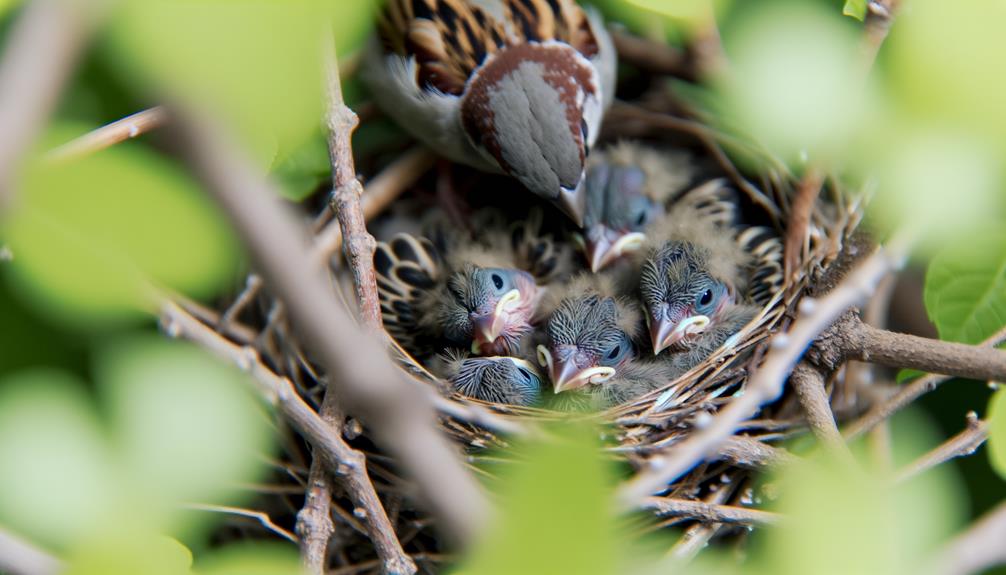
Upon hatching, sparrow chicks emerge blind, featherless, and entirely dependent on their parents for warmth, nourishment, and protection.
In the initial days post-hatching, the altricial chicks exhibit rapid growth and development, primarily fueled by a protein-rich diet provided by the adult sparrows. Observations indicate that the nestlings' metabolic rates are elevated, necessitating frequent feedings.
Parental care encompasses meticulous thermoregulation, essential for the chicks' survival, as they lack the ability to regulate their own body temperature. Nest sanitation is rigorously maintained by the parents, reducing the risk of bacterial and parasitic infections.
These early life stages are pivotal, as they lay the foundation for subsequent physiological and behavioral developments essential for fledging and eventual flight proficiency.
Developing Wing Muscles
The development of wing muscles in sparrows is a vital phase characterized by specific wing strengthening exercises that commence shortly after hatching.
Observational studies indicate that these exercises, which include flapping and stretching, are essential for muscle hypertrophy.
Gradual flight practice then follows, where fledglings engage in short, controlled flights that incrementally enhance their flight endurance and efficiency.
Wing Strengthening Exercises
To develop the necessary wing muscles required for flight, juvenile sparrows engage in a series of instinctual exercises that include flapping, stretching, and short bursts of hopping. These activities contribute to the gradual strengthening of the pectoralis and supracoracoideus muscles, essential for sustained flight. Observations indicate that flapping exercises increase endurance, while stretching enhances flexibility and range of motion. Short bursts of hopping simulate takeoff and landing mechanics, crucial for coordination.
| Exercise Type | Primary Benefit |
|---|---|
| Flapping | Increases stamina |
| Stretching | Enhances suppleness |
| Hopping | Improves synchronization |
| Combined Movements | Muscle fortification |
Evidence-based studies corroborate that consistent engagement in these exercises accelerates the development of robust wing musculature, laying the foundation for future flight capabilities.
Gradual Flight Practice
Engaging in gradual flight trials is crucial for juvenile sparrows to progressively develop the necessary wing muscle strength and coordination for sustained flight.
Observational studies indicate that fledglings initially engage in short, low-altitude hops, which serve as preliminary exercises to build muscular endurance.
As these birds gain confidence and muscle control, they gradually increase the duration and complexity of their flight attempts.
Empirical evidence demonstrates a correlation between the frequency of these practice sessions and the rate of muscle development.
Importantly, electromyographic data reveals heightened activity in the pectoralis and supracoracoideus muscles, crucial for wing flapping.
This step-by-step approach guarantees a balanced acquisition of skills, minimizing the risk of injury while optimizing muscle conditioning and neuromuscular coordination essential for proficient flight.
First Attempts at Flight
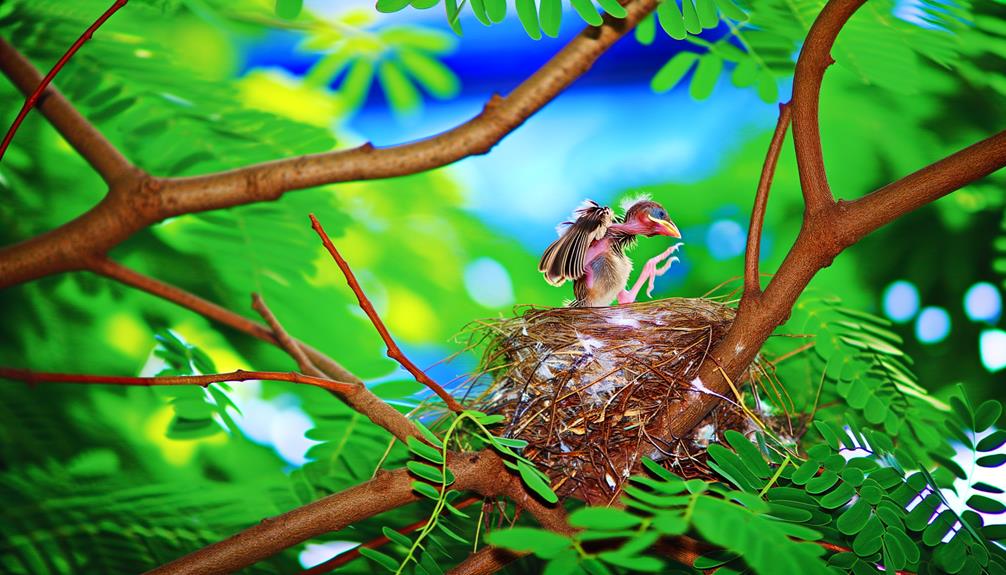
Juvenile sparrows, typically around 10 to 14 days old, initiate their first attempts at flight through a series of short, experimental hops and wing flaps. This nascent stage of flight development is characterized by several observable behaviors:
- Wing Flapping: Repeated, vigorous movements to build muscle strength and coordination.
- Short Hops: Small leaps that test the sparrow's ability to balance and control its body in the air.
- Ground-to-Perch Shifts: Attempts to move between low perches and the ground, enhancing spatial awareness.
- Feather Adjustment: Frequent preening and feather positioning to optimize aerodynamic efficiency.
These actions are critical for developing the necessary musculature and neural pathways that facilitate more sustained flights. These initial movements serve as the foundational steps towards achieving competent flight capabilities.
Parental Guidance
Parental guidance plays an important role in the development of fledgling sparrows' flight abilities. Adult sparrows demonstrate flight techniques which the young observe and emulate, facilitating the acquisition of essential motor skills.
Additionally, parents provide encouragement and gentle nudging, which are essential for motivating fledglings to make repeated flight attempts and overcome initial hesitations.
Observing Adult Flight Techniques
Frequently, fledgling sparrows meticulously observe the intricate flight maneuvers of adult birds, providing a foundational framework for their own aeronautical development. These observations are critical as they enable young sparrows to internalize complex flight patterns and aerodynamic principles. Detailed studies have shown that fledglings focus on several key aspects of adult flight:
- Wing flapping frequency: Monitoring how often adults flap their wings during various maneuvers.
- Takeoff techniques: Observing the precise movements during the initial lift-off from the ground or perch.
- Mid-air adjustments: Learning how adults alter their wing positions to navigate wind currents and obstacles.
- Landing strategies: Understanding the methods used by adults to achieve safe and controlled landings.
These observations are instrumental in the cognitive and motor skill development necessary for independent flight.
Encouragement and Gentle Nudging
Adult sparrows utilize a combination of vocal cues and physical prodding to encourage fledglings to make their initial flight attempts. Detailed observations reveal that parents use specific calls to signal fledglings, creating an auditory environment that stimulates readiness for flight.
These vocalizations are often coupled with gentle nudging or pecking, aimed at prompting the fledglings to leave the nest. Evidence indicates that such physical prodding is strategic, targeting the fledglings' balance and wing coordination.
Studies have shown that this dual approach of auditory and tactile stimulation is essential for the fledglings' successful shift from nest-bound to airborne. This parental guidance not only facilitates motor skill development but also boosts the young sparrows' confidence, ultimately leading to independent flight.
Practicing Short Flights
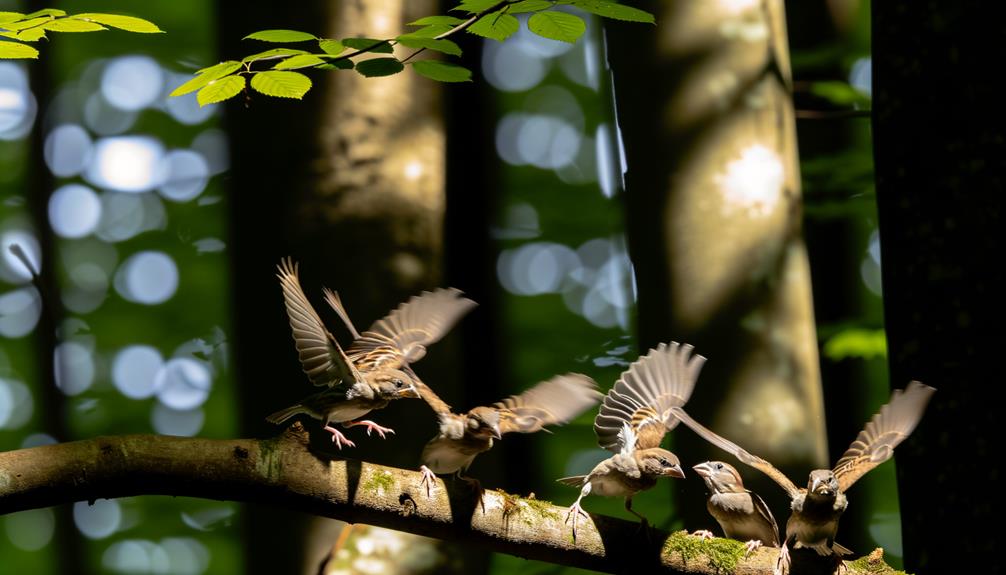
Commencing the journey towards flight, juvenile sparrows engage in brief, controlled flights to develop their muscle strength and coordination. These initial flights are important for honing their aerial capabilities.
During this phase, observable behaviors include:
- Short, low-altitude flights: Sparrows often launch from and return to the same perch, ensuring a safe environment.
- Wing-flapping exercises: Repetitive flapping sessions build the necessary musculature for sustained flight.
- Parent-guided attempts: Adult sparrows demonstrate flying techniques and provide vocal encouragement.
- Progressive distance increments: Gradual increases in flight distance help juveniles adjust to the demands of flight.
These practices are essential for the physiological and neurological development required for proficient flying, as juveniles learn to balance, maneuver, and exert control over their flight paths.
Mastering Navigation Skills
Developing adept navigation skills in juvenile sparrows involves a complex interplay of environmental cues, spatial memory, and genetic predisposition. Research indicates that young sparrows rely on the geomagnetic field, sun position, and polarized light patterns to orient themselves.
Observational studies have shown that parents play a pivotal role by leading fledglings on short forays, thereby enhancing their spatial mapping capabilities. Additionally, spatial memory is fortified through repetitive exposure to the home range, reinforcing neural pathways associated with landmark recognition.
Genetic factors further underpin this learning process, as migratory instincts are inherited traits aiding long-distance navigation. Consequently, the concerted action of these elements enables sparrows to master the sophisticated task of navigation efficiently and effectively.
Conclusion
To sum up, the ontogeny of flight in sparrows involves a series of carefully observed stages, from hatching to the acquisition of advanced navigational abilities.
The strengthening of wing muscles, along with repetitive practice and parental guidance, enables the fledgling to shift from being grounded to becoming an aviator.
These developmental milestones, similar to significant rituals, highlight the delicate equilibrium of instinctual behavior and interaction with the surroundings crucial for flight expertise, inspiring a feeling of wonder at the intricacy of bird life.

